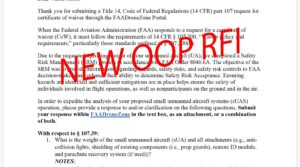Last week the FAA held the AUVSI sponsored 2024 UAS/AAM Symposium. Like previous FAA Symposiums, this was held at the Baltimore Convention Center at Inner Harbor. The venue is a great place to hold it, with plenty of room for keynotes, as well as breakout sessions, and networking events.

And like the previous couple of years, much of the talk centered around where the industry is with BVLOS, and advanced operations such as delivery and advance mobility. But unlike the previous couple of years, the talk this year was definitely more upbeat and positive. Much of that had to do with the newly signed 2024 FAA Reauthorization Act, and it’s very deliberate inclusion of BVLOS recommendations and target dates. More on that.
With the event spread out over three days, and with multiple sessions occurring simultaneously, thoughts in this article are from Adrian Doko, Kenji Sugahara, and myself. So here they are…
_______________________________________________________

From Adrian’s notes:
Since 2018, the FAA has tried to collaborate with the drone/advanced aviation community through its Symposium and this year was the best one yet. It seems like they hit the ground running after a stagnant period of crawling, based on their coveted “Crawl, Walk, Run” mantra and we have the receipts to prove it.
If you haven’t noticed the recent advancements of approvals in complicated airspace operations such as part 107 Operations Over People/Vehicles, Part 137 for agriculture/public health and part 135 for package deliveries. One of the groundbreaking announcements was the authorization of “UTM” (Unmanned Traffic Management) to allow multiple operators to fly commercial drones without visual observers in the same airspace. This comes as the FAA is working on the launch of part 108 (BVLOS) NPRM this year.
Adrian also spoke on a panel called “Gateway to Aviation” about how the FAA is putting money where their mouth is. They are contributing $13.5 million through the AWD (Aviation Workforce Development) to help educate the next generation of advanced aviation professional in rural and urban areas from high schools to colleges that will condition there curriculums to scale the industry.
Although we still have a lot of wood to chop, Kudos to the FAA team for cultivating such diverse input from stakeholders in academia, industry, non-profits and public safety to create a culture of inclusivity, which is a stark contrast to previous heavy handed FAA influence on the narrative.
_______________________________________________________

From Kenji’s notes:
Kenji does agree that there “seemed to be a little more hope this year with the excitement over 108.” With Kenji one of the people who worked so hard on the BVLOS ARC (where the concept of Part 108 was birthed), this was especially satisfying to see his and others’ hard work start to come to fruition. The 2024 FAA Reauthorization Act has given the FAA until September 16, 2024 to “issue a notice of proposed rulemaking establishing a performance-based regulatory pathway for unmanned aircraft systems (in this section referred to as ‘UAS’) to operate beyond visual line of sight…”, according to Section 44811 of the 2024 FAA Reauthorization Act.
Kenji also noted that many from the Traditional (Manned) Aviation side of the industry have become much more amenable to working with the unmanned side, especially the AAM verticals. Kenji noted that “HAI (Helicopter Association International) rebrand[ing] to VAI (Vertical Aviation International)” was definitely a step in the right direction to ensure the continued safety of the NAS, especially around such areas as urban air corridors, where tradition and Advance Air Mobility AAM operations will likely end up sharing much of the airspace.
Being a state representative himself, Kenji noticed many more of his colleagues were present at this year’s Symposium as well. Many of those state officials were part of the Multi-State Collaborative, which is also gaining steam in its own right. Bringing those state level policy makers into the fold will ensure systems and infrastructure will be in place once AAM becomes a reality. The 28 state collaborative recently had a meeting sponsored by both Oregon and Washington State. It will be worth watching the work of this collaborative as the AAM industry matures.
Kenji was part of the “Won’t You Be My Neighbor: Community Engagement for New Entrants” session on that highlighted “the roles and responsibilities of stakeholders as communities consider new entrants’ operations”.
This session covered not only how to engage, but who to engage. We all think about reaching out to the general public when someone is setting up deliveries or AAM routes, but the panel also talked about state and local regulatory bodies as well. Local land use partners are critical to a successful rollout for any AAM operations. Explain in detail just what the benefits of the ongoing operations are for the community is also critical. Explaining the ecological and noise benefit of electric aircraft was a key take away. And the coming AAM uses for rural deliveries of critical medical supplies was emphasized.
Kenji also noted that wildfire response and public safety had a nice high profile this year, and that there was quite a bit of talk about the increase in approvals of both Waivers and exemptions.
Which bring us to my thoughts…
_______________________________________________________

From Vic’s notes:
I was invited to speak on a panel titled, “Unlocking the Skies: Navigating Operational Approvals for Innovative Operations”. We spent some time on that panel talking about how the FAA has improved the process for not only Part 107 Waivers (especially OOP and BVLOS), but only for the Part 91 and Part 135 operators. We also talked about just how some of the sections of the 2024 FAA Reath will do for scalable BVLOS operations.
The FAA folks on that panel (as well as other panels) also used the term “shielded ops” quite frequently. This term applies to UAS operations taking place below or near structures such as buildings. There are obviously already regulations in place that require traditional aviation to stay a certain distance away from structures under normal operations. The FAA is slowly incorporating that same mindset of regulations into the UAS realm. If manned aviation isn’t there, UAS should have virtually unfettered access to is, even BVLOS. Of course there is the issue of non-cooperative aircraft, but that solution will come as well.
With the shorter (4 month) timeline given to the FAA for the BVLOS NPRM, there was more than one question throughout the sessions asking if the FAA would hit that deadline. And on more than one occasion, we were told the would do “everything possible” to make that deadline. Given how much lead time they’ve had studying all of the BVLOS ARC recommendations, if they don’t make it, they shouldn’t miss it by much.
One main component of scalable BVLOS operations is Unmanned Traffic Management (UTM), so critical for safety. It was announced as part of the Symposium keynote that both Zipline and Wing were granted permissions to use their UTM services to deconflict airspace for their delivery systems during flights without visual observers. This is happening in the Dallas/North Texas delivery areas. That was a huge advance for what AAM and package delivery companies are trying to scale.
Of course, we have to ensure that this also doesn’t adversely affect the Part 107 and recreational crowds, but it’s a great first step.
The FAA also was quite adamant that when it comes to more advanced operations (long range BVLOS, etc.), they are going to continue to use their tried and true performance based regulatory process instead of a mandated equipage type process. So, with the BVLOS NPRM and final rule, it’s going to basically say, “this is what you need to do in order to fly these missions, and it’s up to you to figure out how.” They want to leave it up to those doing the work to determine the “how”.
For those of use who can remember the “bring us a rock” mindset in the early days of FAA exemptions and waivers, this should help alleviate some of that fear. Now it would be more along the lines of, “bring me a rock that does this, and tell me how it does this”. That is also a huge step forward.
Another concept we saw mentioned more that usual this year is our industry’s incredible safety record. Our safe operations, in conjunction with the reliability of our equipment, has not gone unnoticed by the FAA. Even some of the “old guard” have realized that our safety record is literally second to none when it comes to NAS usage. That will also go a long way in unlocking even more scalable flights.
The last part I’ll talk about is the reorganization of the FAA’s Emerging Technologies Division AFS 700. In the past, for many of the more complex operational decisions, those applying for exemptions or even waivers, had to have their paperwork looked at by many different section heads. And some of them didn’t really understand the UAS side of the equation.
Earlier this year, the FAA reorganized AFS 700, making the process much smoother. In the panel I was on, there seemed to be some sort of inside joke between all of the FAA employees on that panel when it was brought up. And to a person, they were all very happy with how it’s now working out. Much easier and much less headaches for them. And less headaches for AFS 700 means less headaches (& shorter timelines) for those of us in the flying side of the UAS world.
Does the mean the UAS wold will be all roses and cupcakes from here on out? Nope, not at all. No one (FAA or otherwise) believes that for a second. But the atmosphere and general upbeat attitude of those in the know should be a huge relief for those of use who fly drones for a living. The speed at which things are happening is better than I’ve ever seen.
To reiterate Adrian’s comment about “crawl, walk, run”, I honestly think the FAA is finally walking. I still don’t think they’re at the run stage yet, but I know a number of FAA personnel who are really looking forward to when that happens. And many of them are in a position to push the FAA in that direction.
And finally, we were told that Section 2209 will finally make headway through the regulatory maze this year. For those unfamiliar with 2209, it was mandated back in 2018. Congress gave the FAA & partner agencies marching orders to come up with a list and process of designating actual critical infrastructure where drones would not be allowed. Up to now, we see many states (FL & TX especially) crafting their own CI airspace regulations. With the implementation of 2209, these state regs can be challenged, and hopefully removed. A 6 year deal is even a long one for the FAA. But in their defense, we’ve heard that it’s the federal security agencies (no surprise there) and industries that want an exhaustive list. Other agencies (FAA & DOT) want a less intrusive one. Let’s hope more logical and reasoned heads have prevailed here.
_____________________________________________________________
Drone Service Providers Alliance provides “Professional advocacy for Drone Service Providers throughout the United States”. Our mission statement is “A United Voice for Positive Change”. We are a dues supported 501(c)(6) organization. Dues are used to cover travel and operating expenses. No salaries are taken by Kenji and Vic for the work they do on behalf of the U.S. UAS industry. We fully believe a rising tide lifts all boats. And since we also fly drones for a living, it will benefit us as well.
If you believe in what we do, please consider joining us, we appreciate any and all support: https://dspalliance.org/join-us/.
Also, have you added to your drone fleet? Do you know the ins and outs of your new drone? Check out Pilot Institute’s Deep Dive Videos. Greg and crew do an great job helping you understand your drone better. And each and every Deep Dive Video is free.
Also, if you don’t have your 107 yet, or are looking to add UAS Verticals, check out the Pilot Institute site for additional classes. They have business classes, a VO class (pay for your VOs to take it), mapping, photography, and more. Check out their offerings here!
Need a new drone? Need to rent one for a specific job? Need some repair work done? Blue Skies Drones is your answer to all of these questions.
And if you’re worried about the current anti-China fervor in D.C. and many states, please seriously consider joining Drone Advocacy Alliance. Let’s work together to stop Congress from picking industry winners and losers.

